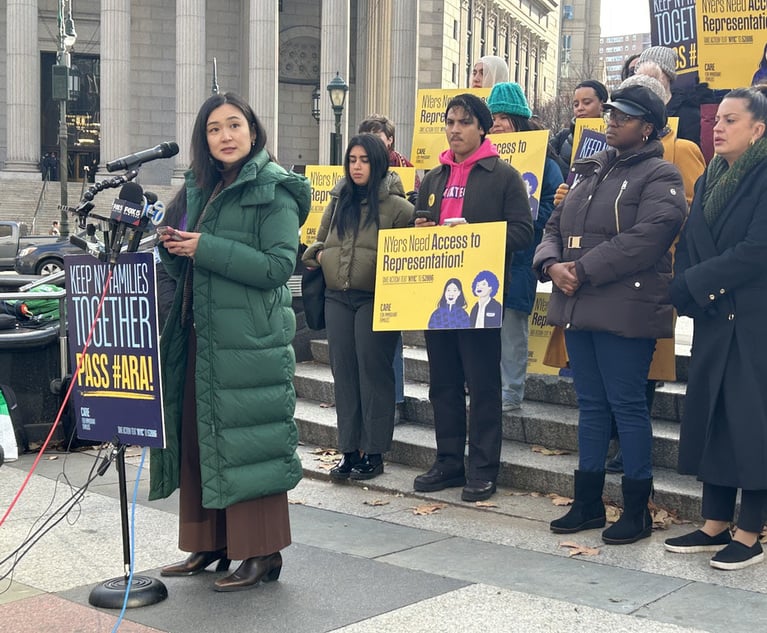Proposed EB-5 Visa Program Reforms
Peter Fisch and Mitchell Berg write: The EB-5 visa program has become a major source of real estate financing nationwide, and in particular for large real estate development projects in New York City such as Hudson Yards in Manhattan, the New York Wheel on Staten Island, and the Pacific Park development in Brooklyn. While the real estate industry has to date been the primary beneficiary of investment dollars generated by the EB-5 program, proposed changes to the program's rules could imperil what has been a reliable source of funding for new development projects.
July 11, 2017 at 02:03 PM
11 minute read
The EB-5 visa program has become a major source of real estate financing nationwide, and in particular for large real estate development projects in New York City such as Hudson Yards in Manhattan, the New York Wheel on Staten Island, and the Pacific Park development in Brooklyn. The EB-5 program provides lawful permanent residence status to immigrants in exchange for an investment of at least $500,000 in a U.S. business venture that creates at least ten permanent jobs. While the real estate industry has to date been the primary beneficiary of investment dollars generated by the EB-5 program, proposed changes to the program's rules could imperil what has been a reliable source of funding for new development projects.1 With the primary component of EB-5 expiring in September, many stakeholders expect at least some structural changes to be adopted by Congress as part of any effort to reauthorize the program under the Trump administration.
The use of EB-5 capital as a source of financing for ground-up development projects is widespread. With the interest rate attached to EB-5 capital as low as 2.75 percent, the cost of the financing is very appealing to developers.2 For foreign investors, the program provides a pathway to invest capital in high profile real estate projects while also providing each investor, and his or her family, a visa and the opportunity to live and work in the United States. Some critics, however, have called for eliminating the EB-5 program entirely, and others have proposed reforms that could have a significant impact on the ability of real estate developers to use the program for future projects. While proposals vary, many of the reforms would increase the current investment thresholds, which have not changed in decades, and enhance federal oversight of so-called regional centers (which pool EB-5 dollars and source most real estate EB-5 investments). Certain proposals would significantly revamp the program's scheme for determining which geographic areas qualify for the most favorable treatment under the program's rules, which could raise the cost of EB-5 financing for developers in the New York metropolitan area.
Regional Centers
In order to assess the potential impact of reform proposals on the local real estate market, it is important to understand the role of regional centers and the designation of targeted employment areas (TEAs) in the program's structure. Regional centers, which were created to allow participation by passive investors, pool EB-5 dollars from various investors to finance projects in a specific geographic area. The designation of a project as within a TEA lowers the investment requirement for program participants from $1 million to $500,000. As a result of these features, the overwhelming majority of EB-5 projects are financed through a regional center and are located in an area designated as a TEA. In 2014, 97 percent of all EB-5 visas issued relied on such investments.3
Funding a project through a regional center also helps investors meet the job-creation threshold of the EB-5 program by removing the onerous requirement, which would otherwise apply, that the immigrant investor directly manage the job-creating business.4 In addition, projects financed through a regional center are able to meet the program's job creation requirements by counting jobs created indirectly through the economic activity of the project—for example, counting any jobs created by a supplier to a construction site. This feature allows investors to count jobs created through the broader economic impact of a particular project, and makes it easier to meet the program's job creation requirements than would otherwise be the case if the investor could only count workers directly employed by the enterprise in which the investment has been made.5
This content has been archived. It is available through our partners, LexisNexis® and Bloomberg Law.
To view this content, please continue to their sites.
Not a Lexis Subscriber?
Subscribe Now
Not a Bloomberg Law Subscriber?
Subscribe Now
NOT FOR REPRINT
© 2024 ALM Global, LLC, All Rights Reserved. Request academic re-use from www.copyright.com. All other uses, submit a request to [email protected]. For more information visit Asset & Logo Licensing.
You Might Like
View All
Immigration Under the Trump Administration: Five Things to Expect in the First 90 Days
10 minute read

Appellate Court Suspends NY Immigration Lawyer Now Practicing in Texas
Trending Stories
- 1Call for Nominations: Elite Trial Lawyers 2025
- 2Senate Judiciary Dems Release Report on Supreme Court Ethics
- 3Senate Confirms Last 2 of Biden's California Judicial Nominees
- 4Morrison & Foerster Doles Out Year-End and Special Bonuses, Raises Base Compensation for Associates
- 5Tom Girardi to Surrender to Federal Authorities on Jan. 7
Who Got The Work
Michael G. Bongiorno, Andrew Scott Dulberg and Elizabeth E. Driscoll from Wilmer Cutler Pickering Hale and Dorr have stepped in to represent Symbotic Inc., an A.I.-enabled technology platform that focuses on increasing supply chain efficiency, and other defendants in a pending shareholder derivative lawsuit. The case, filed Oct. 2 in Massachusetts District Court by the Brown Law Firm on behalf of Stephen Austen, accuses certain officers and directors of misleading investors in regard to Symbotic's potential for margin growth by failing to disclose that the company was not equipped to timely deploy its systems or manage expenses through project delays. The case, assigned to U.S. District Judge Nathaniel M. Gorton, is 1:24-cv-12522, Austen v. Cohen et al.
Who Got The Work
Edmund Polubinski and Marie Killmond of Davis Polk & Wardwell have entered appearances for data platform software development company MongoDB and other defendants in a pending shareholder derivative lawsuit. The action, filed Oct. 7 in New York Southern District Court by the Brown Law Firm, accuses the company's directors and/or officers of falsely expressing confidence in the company’s restructuring of its sales incentive plan and downplaying the severity of decreases in its upfront commitments. The case is 1:24-cv-07594, Roy v. Ittycheria et al.
Who Got The Work
Amy O. Bruchs and Kurt F. Ellison of Michael Best & Friedrich have entered appearances for Epic Systems Corp. in a pending employment discrimination lawsuit. The suit was filed Sept. 7 in Wisconsin Western District Court by Levine Eisberner LLC and Siri & Glimstad on behalf of a project manager who claims that he was wrongfully terminated after applying for a religious exemption to the defendant's COVID-19 vaccine mandate. The case, assigned to U.S. Magistrate Judge Anita Marie Boor, is 3:24-cv-00630, Secker, Nathan v. Epic Systems Corporation.
Who Got The Work
David X. Sullivan, Thomas J. Finn and Gregory A. Hall from McCarter & English have entered appearances for Sunrun Installation Services in a pending civil rights lawsuit. The complaint was filed Sept. 4 in Connecticut District Court by attorney Robert M. Berke on behalf of former employee George Edward Steins, who was arrested and charged with employing an unregistered home improvement salesperson. The complaint alleges that had Sunrun informed the Connecticut Department of Consumer Protection that the plaintiff's employment had ended in 2017 and that he no longer held Sunrun's home improvement contractor license, he would not have been hit with charges, which were dismissed in May 2024. The case, assigned to U.S. District Judge Jeffrey A. Meyer, is 3:24-cv-01423, Steins v. Sunrun, Inc. et al.
Who Got The Work
Greenberg Traurig shareholder Joshua L. Raskin has entered an appearance for boohoo.com UK Ltd. in a pending patent infringement lawsuit. The suit, filed Sept. 3 in Texas Eastern District Court by Rozier Hardt McDonough on behalf of Alto Dynamics, asserts five patents related to an online shopping platform. The case, assigned to U.S. District Judge Rodney Gilstrap, is 2:24-cv-00719, Alto Dynamics, LLC v. boohoo.com UK Limited.
Featured Firms
Law Offices of Gary Martin Hays & Associates, P.C.
(470) 294-1674
Law Offices of Mark E. Salomone
(857) 444-6468
Smith & Hassler
(713) 739-1250







